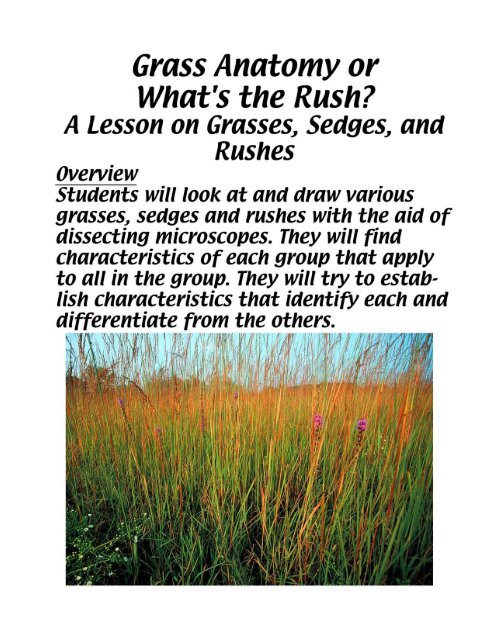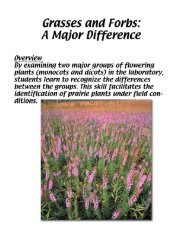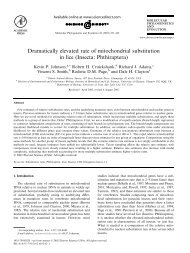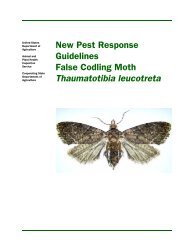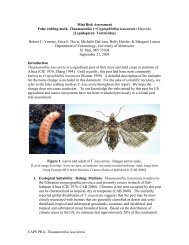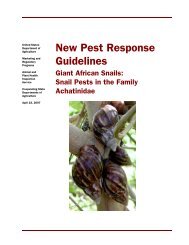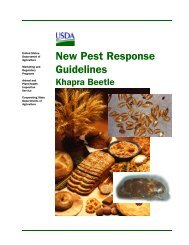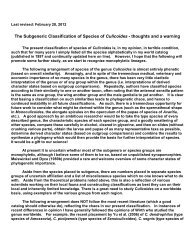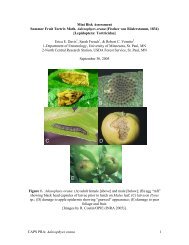Grass Anatomy or What's the Rush? A Lesson on Grasses Sedges ...
Grass Anatomy or What's the Rush? A Lesson on Grasses Sedges ...
Grass Anatomy or What's the Rush? A Lesson on Grasses Sedges ...
You also want an ePaper? Increase the reach of your titles
YUMPU automatically turns print PDFs into web optimized ePapers that Google loves.
Title<br />
<str<strong>on</strong>g>Grass</str<strong>on</strong>g> <str<strong>on</strong>g>Anatomy</str<strong>on</strong>g> <str<strong>on</strong>g>or</str<strong>on</strong>g> <str<strong>on</strong>g>What's</str<strong>on</strong>g> <str<strong>on</strong>g>the</str<strong>on</strong>g> <str<strong>on</strong>g>Rush</str<strong>on</strong>g>—A<br />
<str<strong>on</strong>g>Less<strong>on</strong></str<strong>on</strong>g> <strong>on</strong> <str<strong>on</strong>g>Grass</str<strong>on</strong>g>es, <strong>Sedges</strong>, and <str<strong>on</strong>g>Rush</str<strong>on</strong>g>es<br />
Investigative Questi<strong>on</strong><br />
What makes a grass a grass, and what<br />
are <str<strong>on</strong>g>the</str<strong>on</strong>g> differences between grasses,<br />
sedges, and rushes?<br />
Overview<br />
Students will look at and draw various<br />
grasses, sedges and rushes with <str<strong>on</strong>g>the</str<strong>on</strong>g> aid<br />
of dissecting microscopes. They will<br />
find characteristics of each group that<br />
apply to all in <str<strong>on</strong>g>the</str<strong>on</strong>g> group. They will try to<br />
establish characteristics that identify<br />
each and differentiate from <str<strong>on</strong>g>the</str<strong>on</strong>g> o<str<strong>on</strong>g>the</str<strong>on</strong>g>rs.<br />
Objective<br />
Students will differentiate between<br />
grasses, sedges, and rushes.<br />
Materials<br />
complete c<str<strong>on</strong>g>or</str<strong>on</strong>g>n stalk<br />
copies of student page<br />
samples of grasses, sedges and rushes<br />
(check your local garden center)<br />
binocular <str<strong>on</strong>g>or</str<strong>on</strong>g> dissecting microscopes<br />
f<str<strong>on</strong>g>or</str<strong>on</strong>g>ceps and probes<br />
pressed grass specimens<br />
petri dishes<br />
Time<br />
2 f<str<strong>on</strong>g>or</str<strong>on</strong>g>ty-five minute class periods.<br />
Background<br />
The types of grasses that are present in a<br />
prairie are good indicat<str<strong>on</strong>g>or</str<strong>on</strong>g>s of certain<br />
aspects of <str<strong>on</strong>g>the</str<strong>on</strong>g> health of a prairie. The<br />
germinati<strong>on</strong> rate of grasses is ano<str<strong>on</strong>g>the</str<strong>on</strong>g>r<br />
indicat<str<strong>on</strong>g>or</str<strong>on</strong>g>. There are several<br />
characteristics that are unique to grasses<br />
that are not present in sedges. It is a little<br />
m<str<strong>on</strong>g>or</str<strong>on</strong>g>e difficult to tell <str<strong>on</strong>g>the</str<strong>on</strong>g> grasses from <str<strong>on</strong>g>the</str<strong>on</strong>g><br />
rushes. The instruct<str<strong>on</strong>g>or</str<strong>on</strong>g> should become<br />
familiar with <str<strong>on</strong>g>the</str<strong>on</strong>g>se differences bef<str<strong>on</strong>g>or</str<strong>on</strong>g>e<br />
leading this activity.<br />
Advance Preparati<strong>on</strong><br />
Ga<str<strong>on</strong>g>the</str<strong>on</strong>g>r materials. Set up stati<strong>on</strong>s. F<str<strong>on</strong>g>or</str<strong>on</strong>g> a<br />
class of 24, set up 12 stati<strong>on</strong>s, three f<str<strong>on</strong>g>or</str<strong>on</strong>g><br />
each of grasses, sedges and rushes. Set<br />
up each stati<strong>on</strong> with a dissecting<br />
microscope, 2-3 petri dishes, f<str<strong>on</strong>g>or</str<strong>on</strong>g>ceps,<br />
probes, pressed samples of <str<strong>on</strong>g>the</str<strong>on</strong>g><br />
appropriate type of plant. Bring in some<br />
samples to round out <str<strong>on</strong>g>the</str<strong>on</strong>g> species <str<strong>on</strong>g>the</str<strong>on</strong>g><br />
students bring in. Students should<br />
already have a basic background in <str<strong>on</strong>g>the</str<strong>on</strong>g><br />
anatomy of flowering plants.<br />
Introducing <str<strong>on</strong>g>the</str<strong>on</strong>g> <str<strong>on</strong>g>Less<strong>on</strong></str<strong>on</strong>g><br />
1. In <str<strong>on</strong>g>the</str<strong>on</strong>g> last ten minutes of class, bring<br />
out <str<strong>on</strong>g>the</str<strong>on</strong>g> c<str<strong>on</strong>g>or</str<strong>on</strong>g>n stalk and tell <str<strong>on</strong>g>the</str<strong>on</strong>g> students<br />
you will be investigating <str<strong>on</strong>g>the</str<strong>on</strong>g> differences<br />
between grasses and o<str<strong>on</strong>g>the</str<strong>on</strong>g>r related plants.<br />
2. Ask students if <str<strong>on</strong>g>the</str<strong>on</strong>g>y know what type<br />
of a plant c<str<strong>on</strong>g>or</str<strong>on</strong>g>n is, but if <str<strong>on</strong>g>the</str<strong>on</strong>g>y know, to<br />
keep it to <str<strong>on</strong>g>the</str<strong>on</strong>g>mselves. Let <str<strong>on</strong>g>the</str<strong>on</strong>g>m know<br />
that within <str<strong>on</strong>g>the</str<strong>on</strong>g> next couple of days <str<strong>on</strong>g>the</str<strong>on</strong>g>y
will try to determine what kind of a plant<br />
c<str<strong>on</strong>g>or</str<strong>on</strong>g>n is.<br />
3. Ask students to bring in three <str<strong>on</strong>g>or</str<strong>on</strong>g> m<str<strong>on</strong>g>or</str<strong>on</strong>g>e<br />
examples of grasslike plants. (They<br />
should know to bring <str<strong>on</strong>g>the</str<strong>on</strong>g> entire plant.)<br />
Procedure<br />
1. When students bring in grass samples,<br />
<str<strong>on</strong>g>the</str<strong>on</strong>g>y should be separated into grasses,<br />
sedges and rushes by <str<strong>on</strong>g>the</str<strong>on</strong>g> instruct<str<strong>on</strong>g>or</str<strong>on</strong>g>,<br />
combined with <str<strong>on</strong>g>the</str<strong>on</strong>g> samples he <str<strong>on</strong>g>or</str<strong>on</strong>g> she<br />
already brought in, and placed at <str<strong>on</strong>g>the</str<strong>on</strong>g><br />
proper stati<strong>on</strong>s.<br />
2. Hand out student pages to <str<strong>on</strong>g>the</str<strong>on</strong>g><br />
students.<br />
3. W<str<strong>on</strong>g>or</str<strong>on</strong>g>king in pairs, <str<strong>on</strong>g>the</str<strong>on</strong>g> students should<br />
draw at least three of each—grasses,<br />
sedges and rushes. If needed, <str<strong>on</strong>g>the</str<strong>on</strong>g>y can be<br />
instructed to pay close attenti<strong>on</strong> to<br />
number of plant parts, cross secti<strong>on</strong> of<br />
stems, and arrangement of parts in <str<strong>on</strong>g>the</str<strong>on</strong>g><br />
flowers.<br />
4. Students make up a list of<br />
characteristics that are similar in all of<br />
<str<strong>on</strong>g>the</str<strong>on</strong>g>ir grass samples and how <str<strong>on</strong>g>the</str<strong>on</strong>g>y are<br />
different from <str<strong>on</strong>g>the</str<strong>on</strong>g> o<str<strong>on</strong>g>the</str<strong>on</strong>g>rs. They should<br />
do <str<strong>on</strong>g>the</str<strong>on</strong>g> same f<str<strong>on</strong>g>or</str<strong>on</strong>g> <str<strong>on</strong>g>the</str<strong>on</strong>g> sedges and rushes.<br />
5. Have <str<strong>on</strong>g>the</str<strong>on</strong>g> students make a chart <strong>on</strong> <str<strong>on</strong>g>the</str<strong>on</strong>g><br />
board of all of <str<strong>on</strong>g>the</str<strong>on</strong>g> class findings, and<br />
make some rules f<str<strong>on</strong>g>or</str<strong>on</strong>g> identifying <str<strong>on</strong>g>the</str<strong>on</strong>g><br />
different groups.<br />
6. Once <str<strong>on</strong>g>the</str<strong>on</strong>g>y have come up with a set of<br />
rules f<str<strong>on</strong>g>or</str<strong>on</strong>g> identifying plants to each of <str<strong>on</strong>g>the</str<strong>on</strong>g><br />
groups, each pair of students will <str<strong>on</strong>g>the</str<strong>on</strong>g>n<br />
take an unknown plant and attempt to<br />
identify which group it bel<strong>on</strong>gs to.<br />
7. Students come back toge<str<strong>on</strong>g>the</str<strong>on</strong>g>r and<br />
adjust <str<strong>on</strong>g>the</str<strong>on</strong>g> rules as needed.<br />
Assessing <str<strong>on</strong>g>the</str<strong>on</strong>g> Activity<br />
Give each student an unknown sample.<br />
Using <str<strong>on</strong>g>the</str<strong>on</strong>g>ir new set of rules, ask <str<strong>on</strong>g>the</str<strong>on</strong>g>m to<br />
identify what type of plant it is. They<br />
should also write d<strong>on</strong>e <str<strong>on</strong>g>the</str<strong>on</strong>g>ir reas<strong>on</strong>s f<str<strong>on</strong>g>or</str<strong>on</strong>g><br />
identifying it as <str<strong>on</strong>g>the</str<strong>on</strong>g>y have.<br />
Alternate assessment: Have students<br />
identify which group <str<strong>on</strong>g>the</str<strong>on</strong>g> c<str<strong>on</strong>g>or</str<strong>on</strong>g>n stalk<br />
bel<strong>on</strong>gs in.<br />
Extending <str<strong>on</strong>g>the</str<strong>on</strong>g> Activity<br />
Using <str<strong>on</strong>g>the</str<strong>on</strong>g> same procedure, students<br />
could find <str<strong>on</strong>g>the</str<strong>on</strong>g> differences and<br />
similarities between <str<strong>on</strong>g>the</str<strong>on</strong>g> comm<strong>on</strong> prairie<br />
grasses and make a dichotomous key to<br />
identify <str<strong>on</strong>g>the</str<strong>on</strong>g>se plants.<br />
State Goals<br />
11, 12<br />
C<strong>on</strong>cept<br />
<str<strong>on</strong>g>Grass</str<strong>on</strong>g>like plants making up a prairie can<br />
be grouped and identified by certain<br />
characteristics.<br />
Safety and Waste Disposal<br />
Students should be warned to avoid<br />
plants such as pois<strong>on</strong> ivy and parsnip.<br />
<str<strong>on</strong>g>Grass</str<strong>on</strong>g>es should be composted.
Student page 1 -- <str<strong>on</strong>g>Grass</str<strong>on</strong>g> <str<strong>on</strong>g>Anatomy</str<strong>on</strong>g><br />
Name _____________________________<br />
GRASS SEDGE RUSH (Circle <strong>on</strong>e)<br />
Draw <str<strong>on</strong>g>the</str<strong>on</strong>g> full plant, a close-up of <str<strong>on</strong>g>the</str<strong>on</strong>g> flower, and any o<str<strong>on</strong>g>the</str<strong>on</strong>g>r identifying features. Rec<str<strong>on</strong>g>or</str<strong>on</strong>g>d<br />
<str<strong>on</strong>g>the</str<strong>on</strong>g> identifying characteristics of <str<strong>on</strong>g>the</str<strong>on</strong>g> plant.<br />
Specimen number _______<br />
Draw entire plant<br />
Detail of <str<strong>on</strong>g>the</str<strong>on</strong>g> flower<br />
Unique characteristics (infl<str<strong>on</strong>g>or</str<strong>on</strong>g>escence, stem crosssecti<strong>on</strong>,<br />
leaf attachment, etc.)<br />
List identifying characteristics of this plant


